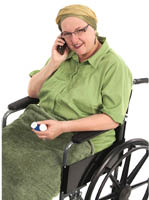:dropcap_open:Y:dropcap_close:our chemotherapy-induced peripheral neuropathy patients are probably sick of taking pills and being stuck with needles. The idea of having to take even more medication after their chemotherapy is over can be frustrating.
They’ve made it through chemotherapy and all the side effects they expected. Now, they’re suffering from: 1
- Shooting pain
- Burning and numbness

- Tingling in the hands and feet
- Inability to sleep because of pain
To say they’re frustrated would be an understatement. Many chemotherapy-induced peripheral neuropathy patients are turning to complementary alternative medical techniques for relief. In many communities, DCs are leading the way.
Some of the more popular treatments sought by patients are:
- Massage therapy
- Physical therapy
- Chiropractic care
These treatment options can often help provide some relief to your chemotherapy-induced peripheral neuropathy patients. But the real power is in learning more about what good care can do for these patients. Your first step in the clinic is getting them to take advantage of your advanced education and expertise.
Here’s how you can help your chemotherapy-induced peripheral neuropathy patients understand exactly how these options work:
Massage Therapy
Massage therapy is rubbing the soft tissues of the body. It not only helps chemotherapy-induced peripheral neuropathy patients by reducing pain and tension, it improves blood flow.
Improved blood flow makes it less likely that chemotherapy-induced peripheral neuropathy will cause permanent nerve damage and can even help to reduce any damage they already have. Aside from those benefits, massage therapy also encourages relaxation. Just being able to relax helps to relieve pain.
When Physical Therapy May Help Too
Physical therapy is treatment that improves mobility and makes it easier to get the body moving again. Once patients are able to move again, they can start exercising and getting their body back into shape. 2
Physical therapists use exercise, mobilizations, education, heat, cold and techniques to help improve their chemotherapy-induced peripheral neuropathy patients’ nerve damage. PTs work side by side with DCs and MDs in many offices, as well as in outpatient settings and progressive hospitals.
Explaining Chiropractic Care
Chiropractic treatment includes manual adjustments of the spine and skeletal structure to put the body back into the best biomechanical function. But, when a patient has been in pain for a period of time, like a chemotherapy-induced peripheral neuropathy patient, the body often has significant mechanical dysfunction, which chiropractors understand can have far-reaching effects on their patient’s overall health. Uncorrected, that leads to even more pain. Great chiropractic care is often another successful alternative therapy when combined with a multifaceted approach to health and chemotherapy recovery. Once the skeletal structure is optimized, other modalities can be implemented in a logical fashion. DCs can be trained in a highly specialized protocol for the treatment of patients suffering from chemotherapy-induced peripheral neuropathy. Combination treatment protocols often include physical therapy, manual manipulation of the spine and skeletal structures, exercise, prescriptions, massage, diet and nutrition counseling and other treatments designed specifically for the individual patient. Getting the proper training can help these patients and save them from spending their post-cancer lives in pain. And when you have that training, we’ll help you educate them on their best chance for a pain-free life.
Reference:
